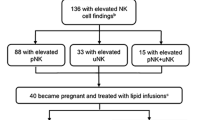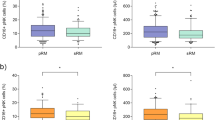Abstract
Aim
Abnormal natural killer (NK) cell activity has been suggested to be a high-risk factor associated with unexplained recurrent spontaneous abortion (URSA). Intralipid, like immunoglobulin, is able to lower the activity of NK cells, which has been reported to be useful for improving URSA outcomes in pregnancy. This study aimed to determine whether intralipid could be used as an alternative treatment to intravenous immunoglobulin (IVIG) which is expensive and has many side-effects.
Methods
A prospective, randomized clinical trial was conducted from December 2010 to December 2012. Eligible participants were matched and sorted randomly into the intralipid and the IVIG group. The primary outcome was the rate of successful pregnancy. In addition, comparisons of peripheral NK cell activities were accessed by flow cytometry. Moreover, the effects of intralipid on trophoblasts were investigated using a Matrigel assay with the JEG-3 cell line.
Results
Seventy-six patients in the intralipid group and 78 in the IVIG group completed the trial. There were no statistically significant differences in successful pregnancy rates between the two groups (92.1 vs 88.2 %, P = 0.415). The reduced NK cell concentrations revealed the cytotoxic effects of the treatments in both groups. The invasive ability of JEG-3 cells was inhibited during co-culture with patient PBMCs. However, the inhibitory effect could be alleviated if the patient PBMCs were stimulated with intralipid.
Conclusions
Intralipid can be used as an alternative treatment to IVIG for URSA, and its potential mechanism of action may occur by regulating NK cell function and promoting trophoblast invasion.




Similar content being viewed by others
Change history
23 October 2021
A Correction to this paper has been published: https://doi.org/10.1007/s00404-021-06267-5
References
Quenby S, Nik H, Innes B et al (2009) Uterine natural killer cells and angiogenesis in recurrent reproductive failure. Hum Reprod 24:45–54
Shakhar K, Ben-Eliyahu S, Loewenthal R et al (2003) Differences in number and activity of peripheral natural killer cells in primary versus secondary recurrent miscarriage. Fertil Steril 80:368–375
Katano K, Suzuki S, Ozaki Y et al (2013) Peripheral natural killer cell activity as a predictor of recurrent pregnancy loss: a large cohort study. Fertil Steril 100:1629–1634
Omwandho CO, Gruessner SE, Roberts TK et al (2004) Intravenous immunoglobulin (IVIG): modes of action in the clinical management of recurrent pregnancy loss (RPL) and selected autoimmune disorders. Clin Chem Lab Med 42:359–370
Ramos-Medina R, Garcia-Segovia A, Gil J et al (2014) Experience in IVIg therapy for selected women with recurrent reproductive failure and NK cell expansion. Am J Reprod Immunol 71:458–466
Coulam CB, Acacio B (2012) Does immunotherapy for treatment of reproductive failure enhance live births? Am J Reprod Immunol 67:296–304
Christiansen OB, Nielsen HS, Pedersen B (2004) Active or passive immunization in unexplained recurrent miscarriage. J Reprod Immunol 62:41–52
Granato D, Blum S, Rossle C et al (2000) Effects of parenteral lipid emulsions with different fatty acid composition on immune cell functions in vitro. JPEN J Parenter Enteral Nutr 24:113–118
Mayer K, Meyer S, Reinholz-Muhly M et al (2003) Short-time infusion of fish oil-based lipid emulsions, approved for parenteral nutrition, reduces monocyte proinflammatory cytokine generation and adhesive interaction with endothelium in humans. J Immunol 171:4837–4843
Kutza J, Murasko DM (1994) Effects of aging on natural killer cell activity and activation by interleukin-2 and IFN-alpha. Cell Immunol 155:195–204
Bansal AS, Bajardeen B, Thum MY (2012) The basis and value of currently used immunomodulatory therapies in recurrent miscarriage. J Reprod Immunol 93:41–51
Fukui A, Funamizu A, Yokota M et al (2011) Uterine and circulating natural killer cells and their roles in women with recurrent pregnancy loss, implantation failure and preeclampsia. J Reprod Immunol 90:105–110
Kotlan B, Padanyi A, Batorfi J et al (2006) Alloimmune and autoimmune background in recurrent pregnancy loss—successful immunotherapy by intravenous immunoglobulin. Am J Reprod Immunol 55:331–340
Kwak-Kim J, Yang KM, Gilman-Sachs A (2009) Recurrent pregnancy loss: a disease of inflammation and coagulation. J Obstet Gynaecol Res 35:609–622
Shimada S, Takeda M, Nishihira J et al (2009) A high dose of intravenous immunoglobulin increases CD94 expression on natural killer cells in women with recurrent spontaneous abortion. Am J Reprod Immunol 62:301–307
Hutton B, Sharma R, Fergusson D et al (2007) Use of intravenous immunoglobulin for treatment of recurrent miscarriage: a systematic review. BJOG 114:134–142
Christiansen OB, Nielsen HS (2005) Intravenous immunoglobulin in the prevention of recurrent miscarriage: does it work? Chem Immunol Allergy 88:117–127
Roussev RG, Ng SC, Coulam CB (2007) Natural killer cell functional activity suppression by intravenous immunoglobulin, intralipid and soluble human leukocyte antigen-G. Am J Reprod Immunol 57:262–269
Sekhon-Loodu S, Catalli A, Kulka M et al (2014) Apple flavonols and n-3 polyunsaturated fatty acid-rich fish oil lowers blood C-reactive protein in rats with hypercholesterolemia and acute inflammation. Nutr Res 34:535–543
Fournier T, Therond P, Handschuh K et al (2008) PPARgamma and early human placental development. Curr Med Chem 15:3011–3024
Leslie DS, Dascher CC, Cembrola K et al (2008) Serum lipids regulate dendritic cell CD1 expression and function. Immunology 125:289–301
Kostenis E (2004) A glance at G-protein-coupled receptors for lipid mediators: a growing receptor family with remarkably diverse ligands. Pharmacol Ther 102:243–257
Yaqoob P (2003) Fatty acids as gatekeepers of immune cell regulation. Trends Immunol 24:639–645
Chen Y, Perussia B, Campbell KS (2007) Prostaglandin D2 suppresses human NK cell function via signaling through D prostanoid receptor. J Immunol 179:2766–2773
Desmarais JA, Lopes FL, Zhang H et al (2007) The peroxisome proliferator-activated receptor gamma regulates trophoblast cell differentiation in mink (Mustela vison). Biol Reprod 77:829–839
Fournier T, Handschuh K, Tsatsaris V et al (2008) Role of nuclear receptors and their ligands in human trophoblast invasion. J Reprod Immunol 77:161–170
Kowalewski MP, Meyer A, Hoffmann B et al (2011) Expression and functional implications of peroxisome proliferator-activated receptor gamma (PPARγ) in canine reproductive tissues during normal pregnancy and parturition and at antiprogestin induced abortion. Theriogenology 75:877–886
Toth B, Bastug M, Mylonas I et al (2009) Peroxisome proliferator-activated receptor-gamma in normal human pregnancy and miscarriage. Acta Histochem 111:372–378
Pavan L, Tarrade A, Hermouet A et al (2003) Human invasive trophoblasts transformed with simian virus 40 provide a new tool to study the role of PPARγ in cell invasion process. Carcinogenesis 24:1325–1336
Tarrade A, Lai KR, Malassine A et al (2001) Characterization of human villous and extravillous trophoblasts isolated from first trimester placenta. Lab Invest 81:1199–1211
Egawa H, Fujiwara H, Hirano T et al (2002) Peripheral blood mononuclear cells in early pregnancy promote invasion of human choriocarcinoma cell line, BeWo cells. Hum Reprod 17:473–480
Acknowledgments
The authors thank Lu Huiqiong and Lan Tianyun for performing the flow cytometry. This study was funded by the Science and Technology Planning Project of Guangdong Province, China (2011B061200005), the Ph.D. Programs Foundation for youth scholars by the China Education Ministry (20110171120090), the National Natural Science Foundation of China (No. 81170625), 5010 projects at Sun Yat-San University (2012006), the Science and Technology Planning Project of Guangdong Province (2012B031800352), Guangdong Natural Science Foundation (S2013010014411), Fundamental Research Funds for the Central Universities (Youth Program 12ykpy29), and the research funds of Sun Yat-sen Memorial Hospital at Sun Yat-sen University (YY 002013001).
Author information
Authors and Affiliations
Corresponding authors
Ethics declarations
Conflict of interest
The author(s) declare that they have no competing interests.
Additional information
M. Lili, L. Jizong and C. Libin are equal contributors for this study.
The original online version of this article was revised due to correction in the figure 3
Rights and permissions
About this article
Cite this article
Meng, L., Lin, J., Chen, L. et al. Effectiveness and potential mechanisms of intralipid in treating unexplained recurrent spontaneous abortion. Arch Gynecol Obstet 294, 29–39 (2016). https://doi.org/10.1007/s00404-015-3922-8
Received:
Accepted:
Published:
Issue Date:
DOI: https://doi.org/10.1007/s00404-015-3922-8




